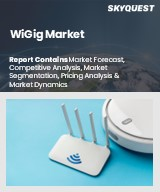
|
시장보고서
상품코드
1512805
5G의 겨울 도래에 대한 통신 벤더의 대응Telco Vendors Navigate Major Market Shifts as 5G Winter Sets In: Telco Spending Downturn Triggers Vendor Consolidation and Operational Overhaul, Cloud Demand Stokes Alliances as Open RAN Gains Traction amid Mixed Outlook |
||||||
2023년 통신 네트워크 인프라벤더의 수익은 연간 9.2% 감소한 2,118억 달러와 2014년 이후 급격한 하락을 기록했습니다. 이 우울은 미국, 중국, 유럽 일부와 같은 주요 시장에서 집중 투자 후 5G 구축이 완료되었음을 반영합니다. 경기감속과 고금리 속에서 통신사업자가 지출을 축소하는 가운데 사업자는 자본상의 제약에 직면하여 벤더 시장에 대한 압력이 강해지고 있습니다.
또한 지정학적 긴장은 공급망과 시장 접근을 혼란스럽게 하며 특히 안보 우려로 Huawei와 ZTE와 같은 공급업체에 영향을 미치고 있습니다. 이러한 과제로 인해 통신사업자들은 국가 안보 우선순위와의 무결성을 확보하기 위해 벤더와의 제휴를 재평가하게 되어 시장 역학이 더욱 변화하고 있습니다. 또한 AWS, GCP, Azure와 같은 웹스케일 클라우드 제공업체의 선두가 클라우드 마이그레이션, AI 통합, 고급 자동화를 통해 통신 인프라를 변화시키고 있으며, 기존 벤더들에게 경쟁 위협과 제휴 기회를 제공합니다.
2024년 벤더 시장 전망은 마을이며, 통신 사업자의 설비 투자의 감소가 예측되는 것 외에, 경제적인 압력이 계속되고 있기 때문에 상반기의 수익 전망은 악화될 가능성이 높습니다. 북미와 유럽 지역별 동향은 광대역의 확대와 중국 이외의 벤더에게 유리한 규제 이동으로 성장이능성을 보여줍니다. 그러나 이들은 상반기 후퇴를 완전히 상쇄하지 못할 수도 있습니다. 2025년 이후에는 대폭적인 성장이 예측되고 있으며, 2024년은 감소로 전환될 가능성이 높은 것으로, 2023년의 전년대비 9.2% 감소할 정도로 심각한 것은 아님을 보여주고 있습니다.
이 보고서는 2024년 중반 통신 업계에서 네트워크 인프라 솔루션(하드웨어, 소프트웨어, 서비스)에 대한 수요를 분석합니다. 지출 증가 전망, 벤더 시장 역학, 현재 시장 환경에 대처하기 위해 벤더가 취해야 할 전략 등에 대해 다룹니다.
언급된 기업
|
|
목차
- 요약
- 주요 시장에서 5G 구축의 종료와 거시 경제의 불확실성 속에서 벤더 시장은 혼란
- 클라우드 프로바이더의 대두, 시장 통합, 벤더의 재검토, 오픈 RAN의 추진에 의해 시장 역학이 변화
- 벤더 시장 전망은 마을 거리 : 2024년 상반기는 어려운 상황이었지만, 2024년 하반기는 개선될 가능성이 있다
- 부록
This brief analyzes demand for network infrastructure solutions (hardware, software, and services) in the telecommunications (telco) industry as of mid-2024. The brief addresses prospects for spending growth, vendor market share dynamics, and what strategies vendors should pursue to cope with the current market environment.
The telecom vendor market is navigating a turbulent landscape shaped by significant shifts and challenges. In 2023, telco network infrastructure (telco NI) vendor revenues declined sharply, down 9.2% annually to $211.8 billion, marking the steepest drop at least since 2014. This downturn reflects the completion of 5G buildouts in major markets like the US, China, and parts of Europe, following a period of intense investment. As telcos scale back spending amid economic slowdowns and high interest rates, operators face capital constraints, intensifying vendor market pressures.
Adding to the complexity are geopolitical tensions disrupting supply chains and market access, notably impacting vendors like Huawei and ZTE, due to security concerns. These challenges have prompted telcos to reevaluate vendor partnerships to ensure alignment with national security priorities, further reshaping market dynamics. Meanwhile, the rise of webscale cloud providers - AWS, GCP, and Azure - is transforming telecom infrastructure through cloud migration, AI integration, and advanced automation, posing both competitive threats and partnership opportunities for traditional vendors.
The top three telco NI vendors remain the same as for the last few years: Huawei, Ericsson, and Nokia, with aggregate share totaling just under 38%, unchanged from 2022. Despite this apparent stability, significant market shifts are unfolding. These shifts, sparked by a downturn in telco spending, include vendor consolidation illustrated by Broadcom's acquisition of VMware, HPE-Juniper, and Nokia-Infinera; alongside operational restructuring and widespread layoffs across the industry. Additionally, cloud providers are reshaping the vendor landscape by offering cloud-based telecom solutions, albeit with modest market share gains. Another notable shift is the push for Open RAN adoption by established vendors and telcos who are increasingly embracing open architectures supported by substantial government investments. Developments such as AT&T's partnership with Ericsson and Deutsche Telekom's collaboration with Nokia reflect growing momentum towards open, interoperable networks, albeit with integration challenges and slower-than-expected uptake among brownfield operators.
Looking ahead, the vendor market faces a mixed outlook for 2024, with projected telco capex declines and ongoing economic pressures likely to dampen revenue prospects in the first half. Regional developments in North America and Europe offer pockets of growth potential, driven by broadband expansion and regulatory shifts favoring non-Chinese vendors. But these may not fully offset the first-half setbacks. Substantial gains are projected from 2025 onward, indicating that while 2024 is likely to decline, it won't be as severe as 9.2% YoY drop in 2023.
Companies mentioned:
|
|
Table of Contents
- Summary
- Vendor market roils as 5G buildouts end in key markets amid macroeconomic uncertainty
- Market dynamics shift amid cloud providers' rise, market consolidation, vendor overhaul, and Open RAN push
- Mixed outlook for vendor market as challenging 1H24 may potentially improve in 2H24
- Appendix
Figures:
- Figure 1: Annualized Telco NI vendor revenues ($B) vs. YoY annualized sales growth (%)
- Figure 2: Annualized market share of top 5 vendors in the telco vertical, 4Q19-4Q23
- Figure 3: Annualized vendor revenues ($B) in telco vertical, 4Q19-4Q23
Tables:
- Table 1: Outlook commentary for select key vendors



















